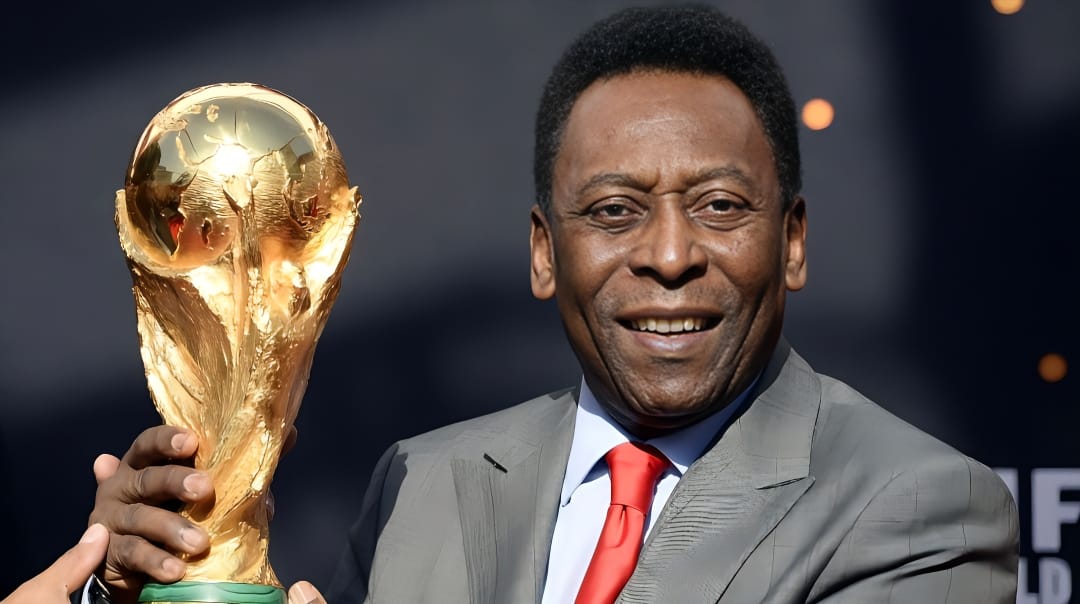Listen to Podcast:
Pele was regarded as the greatest football player of all time and the eternal king of the beautiful game. He has died of colon cancer. He was 82.
With Brazil, he won the World Cup in 1958, 1962, and 1970, and his opulent array of abilities made him the poster child for his nation’s heyday of football.
Pele had already scored more than 1,000 goals when he ultimately decided to retire in 1977. Only Neymar’s 77 goals for Brazil during the most recent World Cup were higher.
The Top Scorer
In 1957, Pele was called up to the Santos senior team, where he scored the first of many goals in his debut. He swiftly won a starting spot and became the league’s best scorer in his first year.
Pele was called up to the Brazilian national squad just ten months after signing as a professional. At the Maracana, he made his international debut against Argentina, which Brazil defeated 2-1.
READ ALSO: Football King Pele Biography
Pele, just 16, scored their goal, making him the youngest player to score in an international. When he suffered a knee injury, it appeared like his chances of playing for Brazil in the 1958 World Cup were over. However, his teammates persuaded the management to pick him, and he made his World Cup debut against the Soviet Union.
Hat-trick
He became the youngest player in World Cup history when he scored against Wales in the quarter-finals.
Brazil was leading France 2-1 in the semi-finals when Pele scored a hat-trick in the second half to put the game out of reach. He appeared to be unstoppable as he stroked two goals past Sweden in the final, which Brazil won 5-2.
Back in Brazil, Pele helped Santos win the main league tournament in Sao Paulo in 1958, finishing the season as the top scorer. A memorable victory over European champions Benfica occurred in 1962. Pele’s hat-trick in Lisbon destroyed the Portuguese team and earned the respect of goalie Costa Pereira.
National treasure of soccer
After joining Santos, Pelé immediately began working out with the team’s regulars. Before he was 16, he scored his first professional goal, and in his first full season, he led the league in goals. He was then drafted to play for the Brazilian national team.
Pelé made his public debut during the 1958 World Cup in Sweden. The 17-year-old scored three goals in a 5-2 semifinal victory against France before adding two more in a 5-2 victory over the host nation. He displayed exceptional speed, athleticism, and field vision throughout the tournament.
Young superstar received substantial offers to play for European clubs, and Brazilian President Jânio Quadros ultimately had Pelé labeled a national treasure, making it legally challenging for him to play in another nation. The Santos club’s management nevertheless scheduled lucrative exhibition games with clubs from around the world to make sure its star draw was well compensated.
World Cup Titles
The 1962 World Cup in Chile saw Pelé miss the semifinals after aggravating a groin ailment. Brazil went on to win the tournament for the second time in a row. Brazil was eliminated from the World Cup after one round four years later in England due to a series of vicious attacks by opposing defenders that once more sent him to the sidelines with leg injuries.
The reputation of Pelé grew despite the setback on the international stage. In order to watch Pelé play in an exhibition game in Lagos, the two groups in the Nigerian Civil War purportedly agreed to a 48-hour ceasefire in the late 1960s.
Brazil and Pelé made a spectacular comeback to success at the 1970 World Cup in Mexico. Leading a strong team, Pelé scored four goals throughout the competition, including one in the championship game that helped Brazil defeat Italy 4-1.
When Pelé declared his retirement from soccer in 1974, the NASL was not yet a popular league. However, Pelé was persuaded to return the following year to play for the New York Cosmos. In an exhibition game between New York and Santos in October 1977, he played his final match while representing both teams. He finished his career with 1,281 goals throughout 1,363 appearances.
Ambassador
To commemorate his retirement, Pele’s former team Santos played Cosmos in a sold-out match in 1977. He engaged in a full game with each side.
READ MORE: Messi – The Greatest Ever
Pele, who was already among the highest-paid athletes in the world, kept on making money even after he stopped playing. In the 1981 movie Escape to Victory, he appeared alongside Sylvester Stallone and Michael Caine.
He has a variety of sponsorship agreements and endorsements, and his name is still well-known all over the world. He was named a UN ambassador for ecology and the environment in 1992, and he later became a goodwill ambassador for Unesco.
ALSO READ: Lionel Messi vs Kylian Mbappe
In a ceremony held at Buckingham Palace five years later, he was appointed an honorary Knight Commander of the British Empire. Pele played a key part in efforts to eradicate corruption in Brazilian football after Fernando Henrique Cardoso, the president of Brazil, appointed him minister of sports in 1995. Pele’s Law, which was passed in 1998, is credited with modernizing the country’s administration of sport.
But he resigned from his position with the UN after being accused of engaging in corrupt behavior, despite the lack of evidence.
Global Brand
Even individuals who have no interest in or knowledge of football can immediately recognize the global brand Pele. He even made the quip that only Pele, Coca-Cola, and Jesus were truly global brands.
He was one of the select few individuals whose fame extended beyond their own sport. Later in life, he struggled to recover from the results of a hip operation, frequently appearing in a wheelchair.
However, in his prime, millions were entertained by his incredible athleticism, and his natural brilliance earned him the admiration of both teammates and rivals.




































